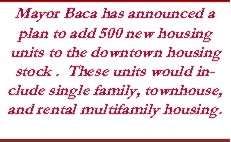NM APARTMENT
1 9 8 9
REPORT
1 9 9 8

"HIGHLIGHTS FROM GRUBB & ELLIS MARKET
FORECAST
JANUARY 1"
Originally appeared inNew Mexico Apartment Report Vol. 5.2 - Q2’98
This article is a summary of a three hour multifamily market forecast held by Grubb & Ellis|Lewinger Hamilton Inc, on January 29, 1998. The following are highlights from the Powerpoint presentations, presented in bullet/summary format.
All of the forecast speakers have a diverse background of experiences in issues that face multifamily real estate today.
1) Doug Crandall - recently retired from his short twenty year stint as Zoning Hearing Officer for Albuquerque, Mr. Crandall discussed the forthcoming problems for landlords who own properties that are impacted by conditional use or non-conditional use zoning, most of which expires in 1999.
2) Liz Thompson (Landlord Information Network Coop) – Liz discussed effective tenant screening techniques (see attached article).
3) Dale Dekker - one of the southwest's leading
architects covered the future of multifamily design - (Dekker/Perich is responsible for more than 1,500 projects totaling more than $350 million and was Funded in 1959)
Highlights of Dale's presentation
1. Sites with utilities and services will increase in value
2. Motivation on the part of city to promote in-fill (overcome NIMBY (not in my backyard) attitude - Big I construction - Closer to where one works - Access to public transportation - Minimize SOV trips (pedestrian linkages)
3. Paseo del Norte Corridor - Higher density/higher land costs - ease of access to employment: North I-25 corridor, Rio Rancho, Intel - Higher rents
4. North of Big I - Cluster housing 10-12 units to the acre for sale and rental
5. Uptown - In-fill - Higher density/higher rents (50 units to the acre) - Close to work, play and shop - Professional market - Condos/flats - Mixed use development (vertical)
6. Downtown - In-fill - City is motivated to provide downtown housing ($) - Higher density (subsidized land costs) walk-ups, 30-50 DU’s - South of the Big I - University/Hospitals/TVI/Airport
7. Small in-fill projects - Student housing - Higher density - Easy access to public transportation (Central Ave. corridor)
8. Air quality issues will drive public transportation options and future land use plans
9. Big I reconstruction will motivate people to start looking into living closer to where they work
10. Job creation and economic development activities are going to focus on creating jobs that pay more
11. Emphasis on in-fill development; less sprawl or fringe development (land costs will increase, forcing densities to also increase) - In-fill development will create projects that must “fit” into neighborhood context (design features, set backs and quality of construction) - The days of the “no brainers” are over
12. The forces that shape our city (economic, political, employment and quality of life) will create “new markets” and, best of all, new OPPORTUNITIES!
Additionally, Todd Clarke CCIM & Joe Azar III CCIM provided a market review -
Current impact on occupancy rate is caused by - first time home buyers, Manufactured home communities, income levels have not kept up with rental increases, lack of federal subsidies, new multi-family construction is less than 7% of total supply and is not significant enough to keep up with job growth, much less impact occupancy rates.
Manufactured Housing - number of units developed in 1980’s - avg. in 300’s per year - Early 1990’s - transition from “Mobile Home” to “Manufactured Housing” - 1995-Today - construction of Manufactured housing matches single family construction (over 3,000 units) YES 3,000+ and with CAVCO’s recently completed plant in Belen (and Karstens forthcoming plant)- they have the ability to produce 10 houses a day.
So how does an apartment community compete? - Focus on tenant retention & services, maintain minimal debt service - allowing the flexibility to lower and raise rents, advertise in new mediums, develop a “niche” for your community - (i.e. who is your primary client), be competitive - offer services, allow pets (with deposit and pet rent), tie-ins with local retailers, develop effective tenant screening programs, focus on services rather than concessions (survey), be tenant-centric as the,y are your client
Additional notes about demand and supply - KAFB is developing a plan to move some 2,121 families off base in the next 18-24 months, regional governments are developing plans to subsidize affordable housing.
Today's market is not quite a buyers market, but prices have remained constant, volume of sales has shrunk, while inventories have reached a peak (over 2,270 units on the market), pent-up supply is looking to complete 1031 exchanges into larger properties, low interest rates allow for higher cash-on-cash returns
From seller’s standpoint incentives to sell - change in capital gains law -28/25/20, 1031 exchange into larger property, seller financing - defers gain over time, substantial equity buildup allows for early retirement, and capital gains tax on residence and lowered capital gains tax allows one to “cash out”.
Again - thanks to our speakers - and -
Look for our next apartment seminar in August of 1998.
Article by
by Todd Clarke CCIM (www.nmcomreal.com/nmcomreal)
p a g e
o n e
